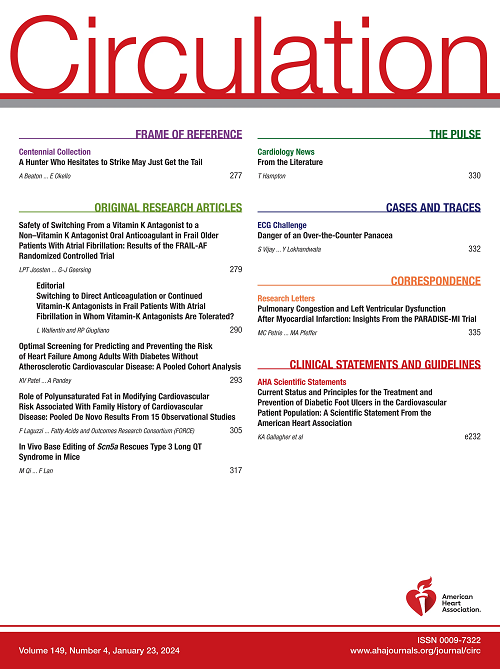METTL3对糖尿病性心肌病的运动益处至关重要
IF 35.5
1区 医学
Q1 CARDIAC & CARDIOVASCULAR SYSTEMS
引用次数: 0
摘要
背景:运动可改善糖尿病性心肌病(DiaCM)患者的功能结局。在DiaCM中,运动对心脏益处的分子机制尚不完全清楚。n6 -甲基腺苷(m6A)是真核生物中最常见的信使RNA修饰形式,与心脏发育和疾病有关。然而,m6A在DiaCM中的作用以及运动对这种疾病的缓解作用尚不清楚。方法将心肌细胞特异性n6 -腺苷-甲基转移酶样3 (METTL3,一种m6A甲基转移酶)基因敲除小鼠及其野生型仔鼠分别以鼠粮或高脂饲料喂养和注射链脲佐菌素诱导DiaCM,然后进行8周的运动训练和心功能评估。部分小鼠注射编码METTL3的腺相关病毒载体,在心肌细胞中过表达METTL3。在无糖尿病或合并糖尿病的非缺血性原发性扩张型心肌病患者中评估心脏METTL3的表达。通过RNA测序鉴定METTL3潜在下游效应物YBX1 (Y-box binding protein 1)。通过腺相关病毒载体在DiaCM小鼠心肌细胞中的过表达或敲低来检测YBX1的功能作用。结果扩张型心肌病患者心肌METTL3蛋白表达和m6A水平下调,扩张型心肌病合并糖尿病患者心肌METTL3蛋白表达和m6A水平进一步下调。一致地,心脏METTL3和m6A在患有DiaCM的小鼠中下调,而运动则上调。心肌细胞特异性METTL3敲除消除了运动对DiaCM的心脏益处。相反,心肌细胞特异性METTL3过表达可改善2种DiaCM小鼠模型的收缩和舒张功能。我们证明了运动通过信号换能器和转录激活因子3增强了心脏METTL3在DiaCM中的表达。此外,METTL3通过m6a依赖的YBX1上调和随后的Nrf2激活来减弱DiaCM。心肌细胞特异性YBX1过表达可促进Nrf2激活,减轻氧化应激,从而改善DiaCM患者的心功能。相反,心肌细胞特异性YBX1基因敲低可消除METTL3对DiaCM小鼠心脏改善的作用。此外,使用小分子药物激活METTL3可减轻DiaCM患者的心功能障碍。这些研究揭示了METTL3在运动对心脏的益处中的重要作用,并确定了METTL3和YBX1是治疗糖尿病的有希望的治疗靶点。本文章由计算机程序翻译,如有差异,请以英文原文为准。
METTL3 Is Essential for Exercise Benefits in Diabetic Cardiomyopathy.
BACKGROUND
Exercise improves functional outcomes in patients with diabetic cardiomyopathy (DiaCM). The molecular mechanism underlying cardiac benefits of exercise in DiaCM remains incompletely understood. N6-methyladenosine (m6A) is the most common form of messenger RNA modification in eukaryotes and has been implicated in cardiac development and disease. However, the role of m6A in DiaCM and in the mitigating effects of exercise on this disease are unclear.
METHODS
Cardiomyocyte-specific N6-adenosine-methyltransferase-like 3 (METTL3, an m6A methyltransferase) knockout mice and their wild-type littermates were subjected to either chow diet or high-fat diet feeding and injection of streptozotocin to induce DiaCM, followed by an 8-week exercise training and assessment of cardiac function. Some of the mice were injected with adeno-associated viral vector encoding METTL3 to overexpress METTL3 in cardiomyocytes. Cardiac METTL3 expressions were assessed in patients with nonischemic primary dilated cardiomyopathies without or with diabetes. Potential METTL3 downstream effector YBX1 (Y-box binding protein 1) was identified through RNA sequencing. The functional role of YBX1 was examined through adeno-associated viral vector overexpression or knockdown in cardiomyocytes in DiaCM mice.
RESULTS
We showed that cardiac METTL3 protein expression and m6A level were downregulated in patient with dilated cardiomyopathy and further downregulated in patients with dilated cardiomyopathy and diabetes. Consistently, cardiac METTL3 and m6A were downregulated in mouse with DiaCM, whereas they were upregulated by exercise. Cardiomyocyte-specific METTL3 knockout eliminated the cardiac benefits of exercise on DiaCM. Conversely, cardiomyocyte-specific METTL3 overexpression improved systolic and diastolic function in 2 DiaCM mouse models. We demonstrated that exercise enhanced cardiac METTL3 expression in DiaCM through signal transducer and activator of transcription 3. Moreover, METTL3 attenuated DiaCM through m6A-depdendent YBX1 upregulation and the subsequent activation of Nrf2. Cardiomyocyte-specific YBX1 overexpression promoted Nrf2 activation and attenuated oxidative stress, resulting in an improvement in cardiac function in DiaCM. In contrast, cardiomyocyte-specific YBX1 gene knockdown abolished the effect of METTL3 on cardiac improvement in mice with DiaCM. Further, pharmacological activation of METTL3 using a small molecule attenuated cardiac dysfunction in DiaCM.
CONCLUSIONS
These studies reveal an essential role of METTL3 in the cardiac benefits of exercise and identify METTL3 and YBX1 as promising therapeutic targets for treating DiaCM.
求助全文
通过发布文献求助,成功后即可免费获取论文全文。
去求助
来源期刊

Circulation
医学-外周血管病
CiteScore
45.70
自引率
2.10%
发文量
1473
审稿时长
2 months
期刊介绍:
Circulation is a platform that publishes a diverse range of content related to cardiovascular health and disease. This includes original research manuscripts, review articles, and other contributions spanning observational studies, clinical trials, epidemiology, health services, outcomes studies, and advancements in basic and translational research. The journal serves as a vital resource for professionals and researchers in the field of cardiovascular health, providing a comprehensive platform for disseminating knowledge and fostering advancements in the understanding and management of cardiovascular issues.
 求助内容:
求助内容: 应助结果提醒方式:
应助结果提醒方式:


